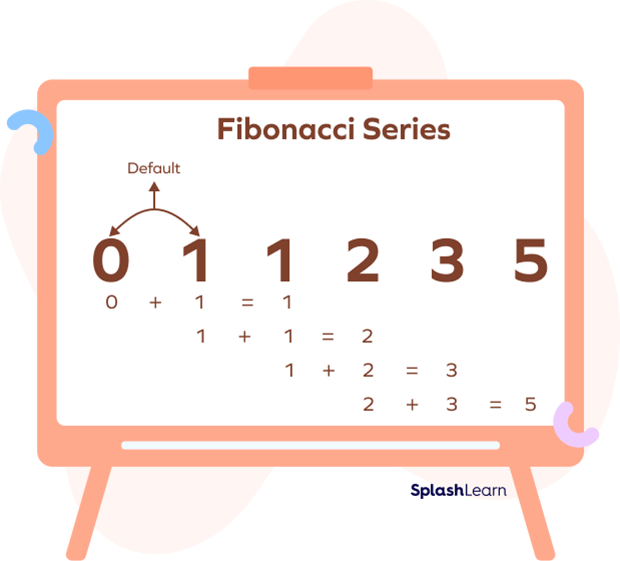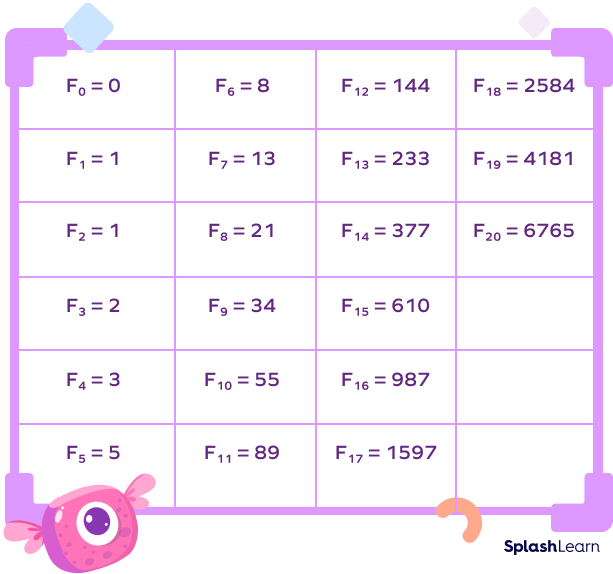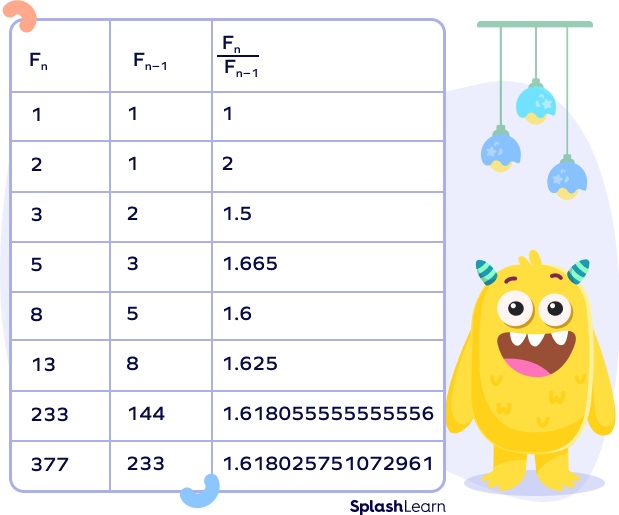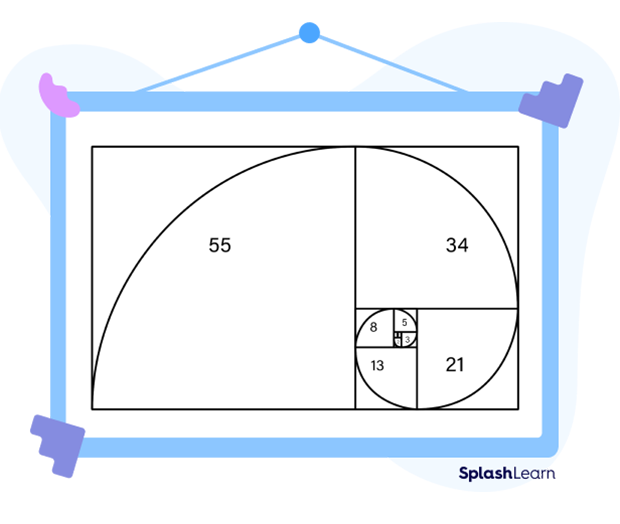What Is the Fibonacci Sequence?
In mathematics, we define the sequence as an ordered list of numbers that follow a particular pattern. The numbers that are present in the sequence are also known as the terms.
One such interesting sequence is given below. What do you observe? Can you identify the pattern?

This sequence is known as the ‘Fibonacci sequence’ in math. If you look closely at the numbers, you can see that each number is the sum of two previous numbers.
Let’s learn the definition, formula, properties, and some interesting facts.
Fibonacci Sequence Definition
The Fibonacci sequence is an infinite sequence that starts with 0 and 1 and continues in such a way that each number is the sum of the previous two numbers.
The numbers in the Fibonacci sequence are also known as Fibonacci numbers. The following image shows the examples of fibonacci numbers and explains their pattern.

The Fibonacci Sequence is given as:
0, 1, 1, 2, 3, 5, 8, 13, 21, …
Here, we obtain the third term “1” by adding the first and second term. $(0 + 1 = 1)$.
Similarly, we obtain “2” by adding the second and third term. $(1 + 1 = 2)$.
So, the term after 21 will be the sum of 13 and 21, i.e., $13 + 21 = 34$. Therefore, the next term in the sequence is 34.
Recommended Games
Fibonacci Sequence Formula
The Fibonacci sequence of numbers, say “Fn” where the suffix n denotes the order or rank of term, is defined by
Initial term: $F_{0} = 0$
First term: $F_{1} = 1$
These two terms together are known as the kick-off part.
Formula for next terms: $F_{n} = F_{n \;-\; 1} + F_{n \;-\; 2}$
This is known as a recursive formula since we repeat the same rule to get the next terms.
$F_{2} = F_{1} + F_{0}$
$F_{3} = F_{2} + F_{1}$
$F_{4} = F_{3} + F_{2}$
$F_{5} = F_{4} + F_{3′}$
and so on.
Note: The sequence starts with 0 (not 1). So, the 4th term of the sequence will be $F_{3}$.
The kick-off part is $F_{0} = 0$ and $F_{1} = 1$
The recursive relation part is $F_{n} = F_{n\;-\;1} + F_{n\;-\;2}$
Recommended Worksheets
Fibonacci Sequence List
The list of fibonacci numbers (up to F20) is given below:

Fibonacci Sequence Properties
The properties of the Fibonacci sequence are given as follows:
- Fibonacci numbers are related to the Golden ratio. In mathematics, two quantities are said to be in golden ratio if their ratio is equal to the ratio of their sum to the larger of the two quantities. It is commonly found in nature, and also in mathematics, design, geometry, etc.
The ratio of any two successive Fibonacci numbers is close to the Golden ratio, which is approximately equal to 1.618034. Any Fibonacci number can be calculated using the golden ratio.
- The ratio of consecutive Fibonacci terms is given below:

By multiplying the previous Fibonacci Number using the golden ratio, i.e., 1.618034, we get the approximated Fibonacci number.
For example, 8 is the sixth term in the sequence. To find the seventh term, we multiply 8 by the golden ratio.
$8 \times 1.618034… = 12.94427… \approx 13$.
- The terms of the Fibonacci sequence below zero can also be calculated by:
$F_{-n} = (\;-\;1)^{n+1}\; F_{n}$.
For example: $F_{-3} = (\;-\;1)^{3+1} \times 2 = 2$.
- There is an interesting pattern in the sequence.
Every 3rd number in the sequence starting from 2 is a multiple of 2.
Examples: $F_{3} = 2,\; F_{6} = 8$
Every 4th number in the sequence starting from 3 is a multiple of 3.
Examples: $F_{4} = 3,\; F_{8} = 21$
Every 5th number starting from 5 is a multiple of 5; and so on.
- The sum of n terms of Fibonacci Sequence is given by:
$\sum_{i=0}^{n}\;F_{i} = F_{n+2}\;-\;F_{2} = F_{n+2}\;-\; 1$, where Fn is the nth Fibonacci number.
For example, the sum of the first 5 terms of sequence $= \sum_{i=0}^{4}\;F_{i} = F_{4+2}\;-\;F_{2}$
$= F_{6}\;-\;1$
$= 8 \;–\; 1$
$= 7$
Fibonacci Spiral
Fibonacci spiral is a geometric pattern or a spiral formed with squares having sides representing the numbers in the Fibonacci sequence. The squares fit together due to the pattern in which Fibonacci numbers occur and thus form a spiral.
Connecting the corners of the squares, the spiral is drawn. The larger the numbers are in the Fibonacci sequence, the closet the ratio becomes to the golden ratio.

In this Fibonacci spiral, every two consecutive terms represent the length and breadth of a rectangle. The following are the ratios of every two successive terms of the Fibonacci sequence.
This spiral can also be observed in nature. Take a look!

Applications of the Fibonacci Sequence in Real Life
The Fibonacci sequence has many applications due to its unique pattern and relation with the golden ratio.
- Computer algorithms, coding theories, security coding, and data structures use Fibonacci numbers.
- Many things in nature follow the Fibonacci sequence. Examples: Branching in trees, arrangement of leaves, pine cone structure.
- It is also used in numerous fields of science that includes high-energy physical science, quantum mechanics, cryptography, etc.
- Finance, trading, and stock markets use the Fibonacci pattern for technical analysis.
Conclusion
In this article, we learned about the Fibonacci sequence, which is a sequence in which a term is the sum of the terms before that. Let’s solve a few examples for better understanding!
Solved Examples on Fibonacci Sequence
1. Find the 11th term of the Fibonacci series if the 9th and 10th terms are 34 and 55 respectively.
Solution: 11th term $=$ 9th term + 10th term, i.e.,
$F_{11} = F_{10} + F_{9} = 55 + 34 = 89$
2. Find the Fibonacci number when $n = 7$, using the recursive relation.
Solution: The formula to calculate the Fibonacci number is: $F_{n} = F_{n\;-\;1} + F_{n\;-\;2}$
Taking $F_{0} = 0$ and $F_{1} = 1$
$F_{2} = 0 + 1 = 1,\; F_{3} = 1 + 1 = 2,\; F_{4} = 2 + 1 = 3,\; F_{5} = 3 + 2 = 5,\; F_{6} = 5 +3 = 8$
$F_{7} = 8 + 5 = 13$
3. Find the sum of the first 6 Fibonacci terms.
Solution: The formula to calculate the sum of the first 6 Fibonacci terms is:
$\sum_{i=0}^{n}\;F_{i} = F_{n+2}\;-\;F_{2} = F_{n+2}\;-\;1$, where $F_{n}$ is the nth Fibonacci number
$\sum_{i=0}^{5}\;F_{i} = F_{5+2}\;-\;F_{2} = F_{7}\;-\;1 = 13\;-\;1 = 12$
4. Find the missing terms in the Fibonacci sequence:
0, 1, 1, 2, 3, 5, 8, 13, 21, ?, ?, …
Solution:
The next term after 21 will be $21 + 13 = 34$.
The next term after 34 is $34 + 21 = 55$
5. Find the value of 14th and 15th terms in the Fibonacci sequence if the 12th and 13th terms are 144 and 233 respectively.
Solution: 14th term $=$ 13th term + 12th term $= 233 + 144 = 377$
15th term $=$ 14th term $+$ 13th term $= 377 + 233 = 610$
Practice Problems on Fibonacci Sequence
Fibonacci Sequence
The first term of the Fibonacci sequence is
The first term in Fibonacci Sequence is $F_{0} = 0$.
If the $16^{th}$ term in the Fibonacci series is 610. Find the next term of the series.
$16^{th}$ term $= 610$. The next term, i.e., $17^{th}$ term $= 610 \times 1.618 = 986.98 \approx 987$
Which of the following is the approximate value of the golden ratio?
The approximate value of the golden rule is 1.618034.
What is the value of $F_{-\;4}$ if $F_{4} = 3$?
$F_{-\;4} = (\;-\;1)^{4+1} 3 = \;-\;3$.
What is the sum of the first 7 terms of the Fibonacci sequence?
Sum of first 7 terms $= F_{6+2}\;-\;F_{2} = 8^{th}$ term $\;–\; 1 = 21 \;–\; 1 = 20$.
Frequently Asked Questions on Fibonacci Sequence
What are the examples of the Fibonacci series in nature?
The Fibonacci series can be spotted in the nature around us in different forms. It can be found in the spirals of the petals of certain flowers such as in the flower heads of sunflowers. We can also find them in the branches of trees.
What is the 100th term of the Fibonacci series?
The 100th term in a Fibonacci series is 354,224,848,179,261,915,075. Using the recursion formula, the 100th term is the sum of the 98th and 99th terms.
What is the importance of the Fibonacci series?
The Fibonacci series is important because it is related to the golden ratio and Pascal’s triangle. Except for the initial numbers, the numbers in the series have a pattern that each number $\approx 1.618$ times its previous number. The value becomes closer to the golden ratio as the number of terms in the Fibonacci series increases.
How is the Fibonacci sequence related to humans?
The number of bones of your finger (from knuckles to wrist) are based on the Fibonacci sequence. Facial proportions are also based on the golden ratio. Human eye finds any object featuring the golden ratio appealing and beautiful.
What fruits show a Fibonacci pattern?
Fruits like the pineapple, banana, persimmon, apple and others exhibit patterns that follow the Fibonacci sequence.




































